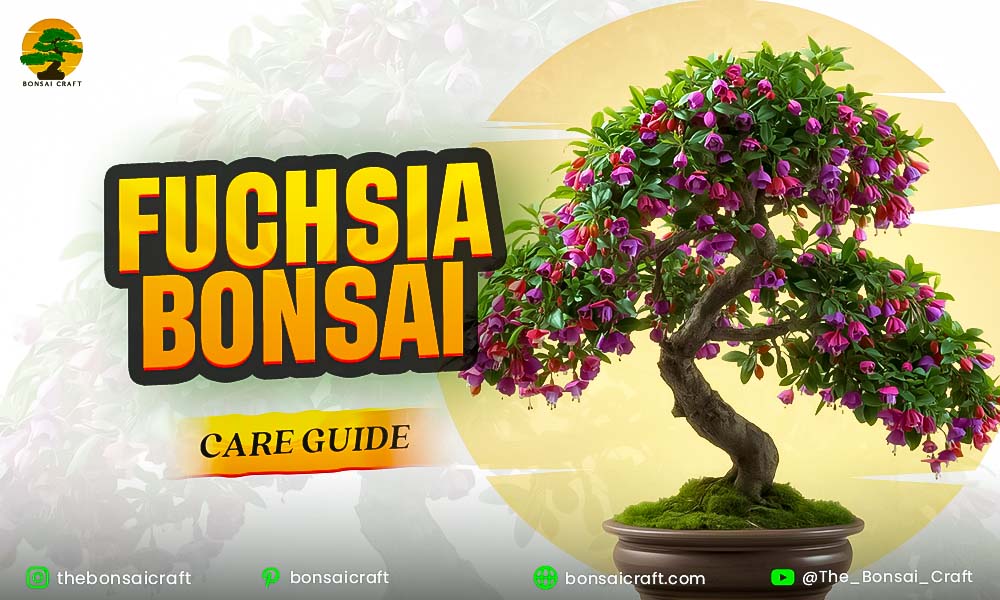
The Fuchsia Bonsai (Fuchsia microphylla) is a stunning flowering bonsai known for its elegant, hanging blossoms that come in vibrant shades of pink, purple, and red. Native to Central and South America, Fuchsia bonsai trees bring a tropical charm and artistic elegance that fit beautifully into both indoor and outdoor settings.
In this Fuchsia Bonsai Care Guide, you’ll learn everything from ideal growing conditions and pruning techniques to repotting, pest control, and year-round maintenance.
Fuchsia bonsai are especially admired for their ability to bloom repeatedly with proper care — offering color, fragrance, and life throughout the growing season.
Understanding the Fuchsia Bonsai
What Makes Fuchsia Bonsai Special?
Fuchsia plants are known for their graceful, drooping flowers and small, glossy leaves. When trained as bonsai, they combine the beauty of ornamental flowers with miniature artistry.
Quick Facts Table
| Feature | Details |
| Botanical Name | Fuchsia microphylla |
| Common Names | Fuchsia bonsai, Dwarf Fuchsia, Lady’s Eardrops |
| Family | Onagraceae |
| Growth Type | Deciduous shrub |
| Suitable For | Indoor and outdoor environments |
| Lifespan | Up to 15–20 years with good care |
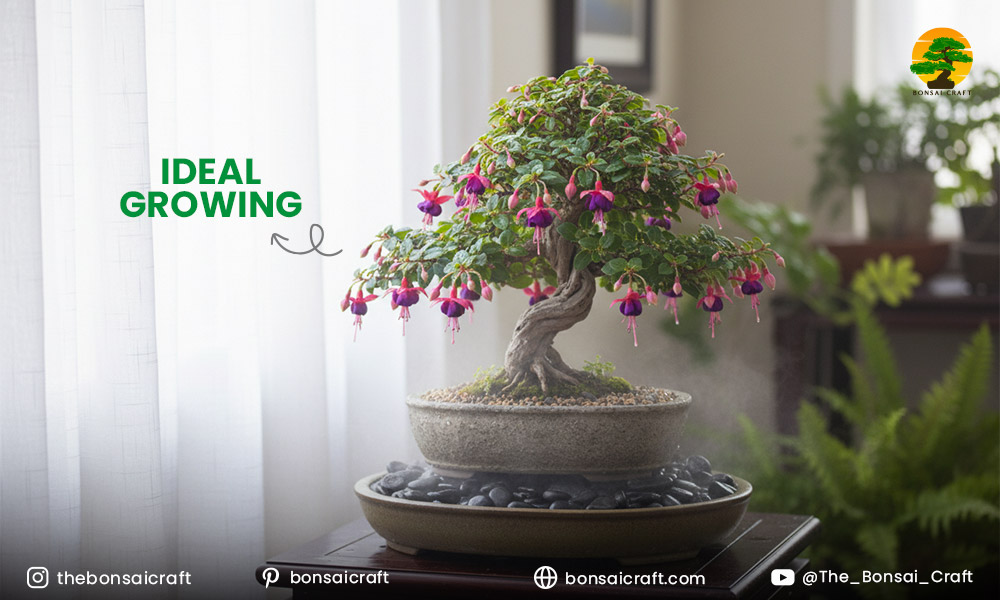
Create the perfect environment for your vibrant Fuchsia bonsai to flourish
Ideal Growing Conditions for Fuchsia Bonsai
Light Requirements
Fuchsia bonsai trees thrive in bright, indirect sunlight. Avoid harsh afternoon rays, as they can scorch the leaves and dry the soil too quickly.
- Indoor Fuchsia Bonsai: Place near an east-facing window.
- Outdoor Bonsai: Give morning sun and afternoon shade.
Research shows that Fuchsia microphylla develops deeper flower colors under filtered sunlight for 4–5 hours daily.
Temperature & Humidity
Fuchsias prefer cool, temperate climates between 60°F–75°F (15°C–24°C). Avoid hot, dry conditions above 85°F (29°C) and protect from frost.
Maintain humidity above 50% by:
- Regularly misting the leaves
- Using humidity trays
- Grouping multiple plants together
Watering Your Fuchsia Bonsai
Water is crucial to keeping your bonsai fuchsia plant healthy and blooming.
- Keep the soil consistently moist but not soggy.
- Water deeply when the top layer feels slightly dry.
- In summer, you may need to water daily; in winter, less frequently.
Avoid letting the soil dry completely — it can cause leaf drop or bud loss.
Expert Tip: Use rainwater or filtered water to prevent mineral buildup, which can harm sensitive roots.
Soil and Fertilizer for Fuchsia Bonsai
Best Soil Mix
Fuchsia roots thrive in well-draining and nutrient-rich soil.
Use a balanced mix such as:
- 40% Akadama
- 30% Pumice
- 30% Organic compost or peat moss
The slightly acidic pH (6.0–6.5) helps in nutrient absorption and vibrant flower production.
Fertilizing Schedule
Feed your bonsai every two weeks during the active growing season (spring to late summer).
Fertilizer Tips:
- Use a balanced liquid fertilizer (10-10-10).
- Before blooming, switch to a phosphorus-rich formula (5-10-5) to enhance flower growth.
- In winter, reduce or stop fertilizing.
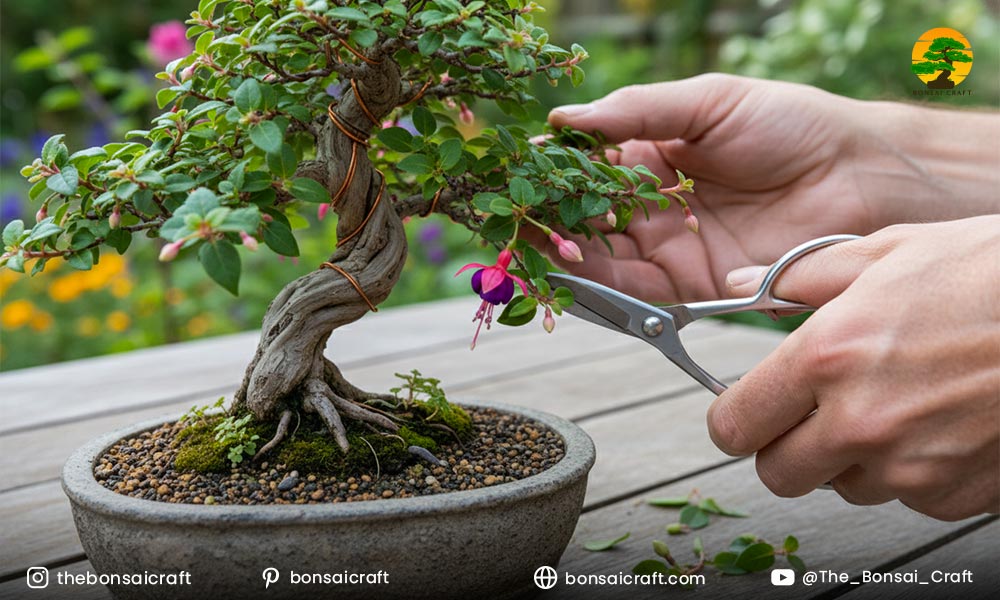
Trim and shape your Fuchsia bonsai for stunning floral displays all year round
Pruning and Shaping Fuchsia Bonsai
Regular Pruning
Pruning helps maintain the bonsai’s compact shape and stimulates new growth.
- Early Spring: Trim old wood and weak shoots.
- After Flowering: Remove dead or faded flowers to promote reblooming.
- Root Pruning: Every 2–3 years during repotting to maintain size and health.
Step-by-Step Fuchsia Bonsai Training
- Choose your preferred style — informal upright, cascade, or broom.
- Use bonsai wire to gently shape branches into position.
- Avoid wiring during the blooming phase to prevent flower damage.
- Always check wire marks and remove them promptly.
Pro Tip: Prune lightly after flowering rather than before — it encourages quicker bud regeneration.
Repotting Fuchsia Bonsai
Fuchsia bonsai should be repotted every 2–3 years, ideally in early spring before new growth starts.
How to Repot:
- Carefully remove the bonsai from its pot.
- Trim about one-third of the root mass.
- Replace old soil with a fresh, well-draining mix.
- Water thoroughly after repotting.
Best Pot Choice: Use a shallow, glazed ceramic pot that complements its colorful blossoms. Blue or white tones work beautifully for display.
Flowering Season and Care Tips
The flowering season for Fuchsia bonsai extends from late spring through early autumn.
To Maximize Blooms:
- Deadhead spent flowers promptly.
- Maintain moderate humidity levels.
- Use bloom-boosting fertilizer with more phosphorus and potassium.
- Avoid excessive nitrogen — it promotes leaves, not flowers.
Under the right humidity and light, each Fuchsia bloom can last up to three weeks.
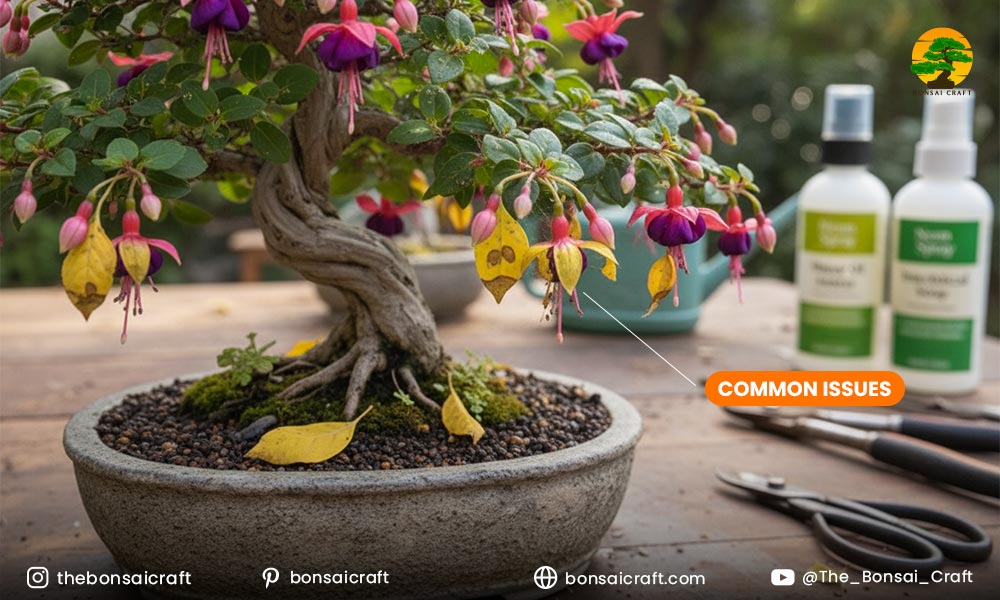
Protect your Fuchsia bonsai from pests and keep it healthy and blooming
Common Problems, Pests, and Diseases
Even the healthiest fuchsia bonsai trees can face occasional challenges.
Common Issues and Solutions
| Problem | Cause | Solution |
| Yellow Leaves | Overwatering | Allow soil to dry slightly between waterings |
| Leaf Drop | Sudden temperature change | Maintain a steady environment |
| Wilting | Heat stress or underwatering | Move to a shaded spot and mist |
| No Flowers | Lack of sunlight or nutrients | Provide more light, phosphorus feed |
Pests
Fuchsia bonsai may attract:
- Aphids
- Whiteflies
- Spider mites
Use neem oil or insecticidal soap weekly until the problem disappears.
Diseases
Watch for root rot and botrytis mold, both of which are caused by poor airflow or overly wet soil. Repot immediately if roots appear black or smell sour.
How to Grow Fuchsia Bonsai from Cuttings
Propagating a fuchsia bonsai tree is simple and rewarding.
Steps to Grow from Cuttings:
- Cut a 4–6-inch healthy stem just below a node.
- Remove lower leaves and dip the cutting in rooting hormone.
- Plant it in a moist, well-draining mix of perlite and peat.
- Cover with a plastic dome or bag to maintain humidity.
- Place in indirect light and keep the soil moist.
Roots usually form within 3–4 weeks under warm (20°C) and humid conditions.
Fuchsia cuttings have a 90% success rate in propagation when maintained at proper humidity.
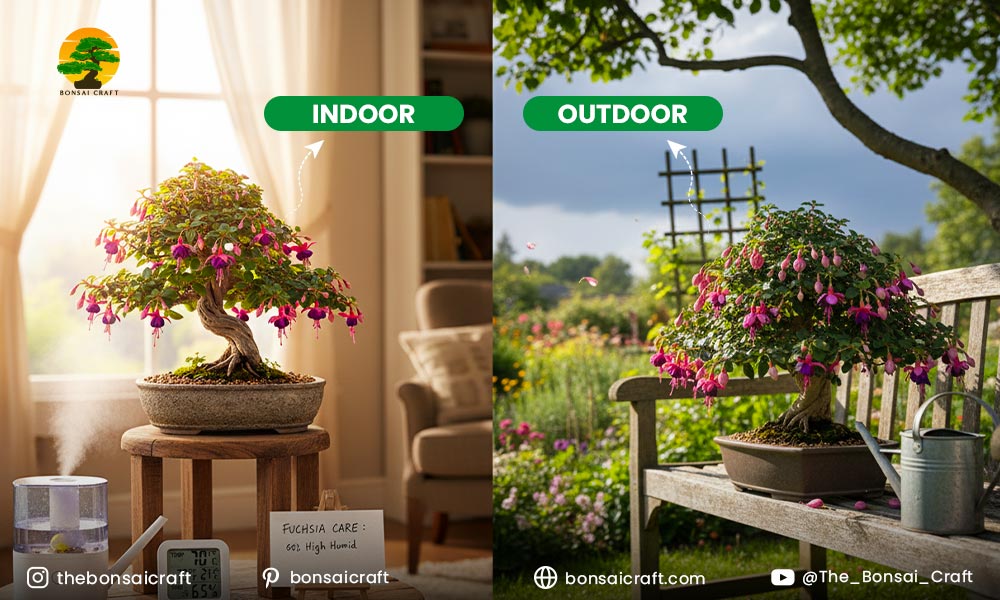
Discover whether indoor or outdoor care best suits your Fuchsia bonsai
Indoor vs Outdoor Fuchsia Bonsai Care
| Aspect | Indoor | Outdoor |
| Light | Bright, indirect | Morning sun, afternoon shade |
| Temperature | 60°F–75°F | 55°F–80°F |
| Humidity | Maintain 50–60% | Naturally higher outdoors |
| Flowering | Moderate | More abundant |
| Watering | Consistent but less frequent | Daily in hot climates |
Tip: During the rainy season or frost, move your outdoor bonsai indoors temporarily to prevent damage.
Conclusion
The Fuchsia Bonsai is a perfect choice for anyone who loves both flowers and bonsai artistry. Its radiant blossoms, graceful shape, and adaptability make it an ideal centerpiece for your home or garden.
By maintaining proper watering, pruning, and light conditions, you can keep your Fuchsia bonsai plant healthy and blooming all year long.
Remember — balance moisture, provide partial sunlight, and prune wisely. Your Fuchsia bonsai will reward you with continuous beauty for many years.
FAQs About Fuchsia Bonsai Care
How often should I water my Fuchsia bonsai?
Water your Fuchsia bonsai whenever the top inch of soil feels dry. During warm months, you may need to water daily. In cooler months, reduce frequency but never let the soil dry out completely to keep the roots healthy.
Can Fuchsia bonsai grow indoors year-round?
Yes, Fuchsia bonsai can grow indoors year-round if given bright, indirect light and adequate humidity. Keep it away from heating vents or air conditioners, as sudden temperature changes can stress the plant and cause leaf drop.
When should I repot my Fuchsia bonsai?
Repot your Fuchsia bonsai every 2–3 years in early spring before new growth begins. Use a well-draining soil mix and trim about one-third of the roots to encourage healthy development and prevent root-bound conditions.
How do I keep my Fuchsia bonsai blooming longer?
To extend blooming, provide 4–5 hours of indirect sunlight daily, prune faded flowers, and use a phosphorus-rich fertilizer during the blooming season. Consistent watering and humidity also help maintain vibrant, long-lasting blooms.
Why are my Fuchsia bonsai leaves turning yellow?
Yellow leaves often indicate overwatering or poor drainage. Allow the soil to dry slightly between waterings, improve pot drainage, and check for root rot. Avoid waterlogging to restore your bonsai’s healthy green foliage.
